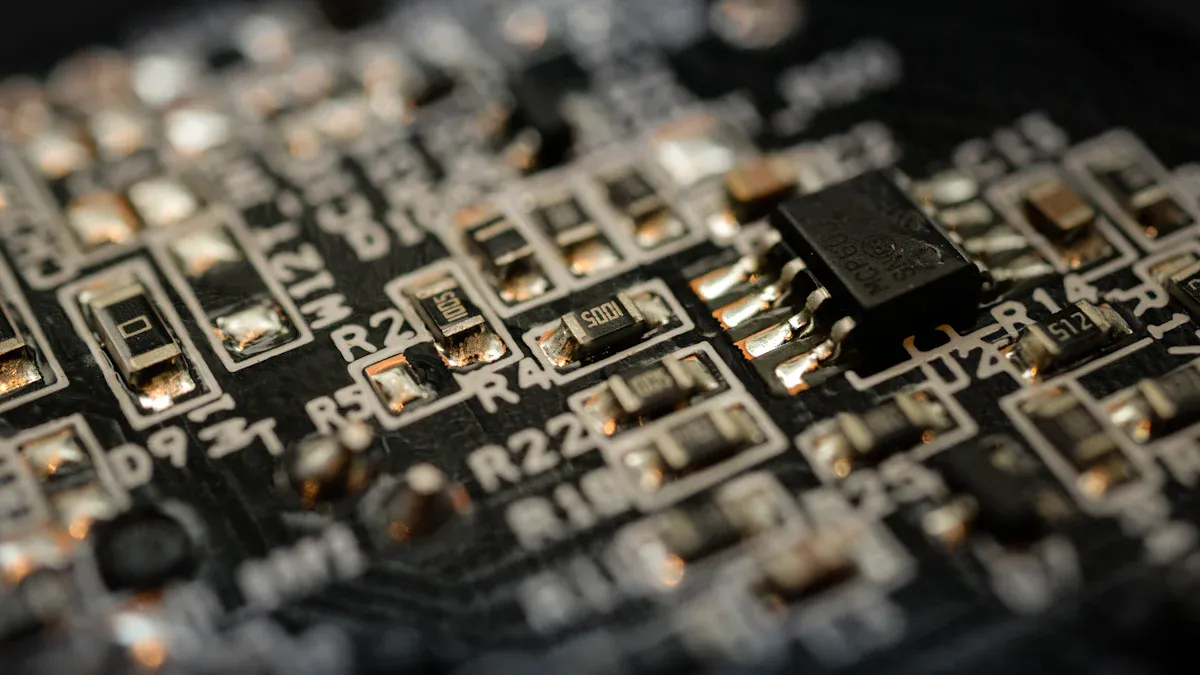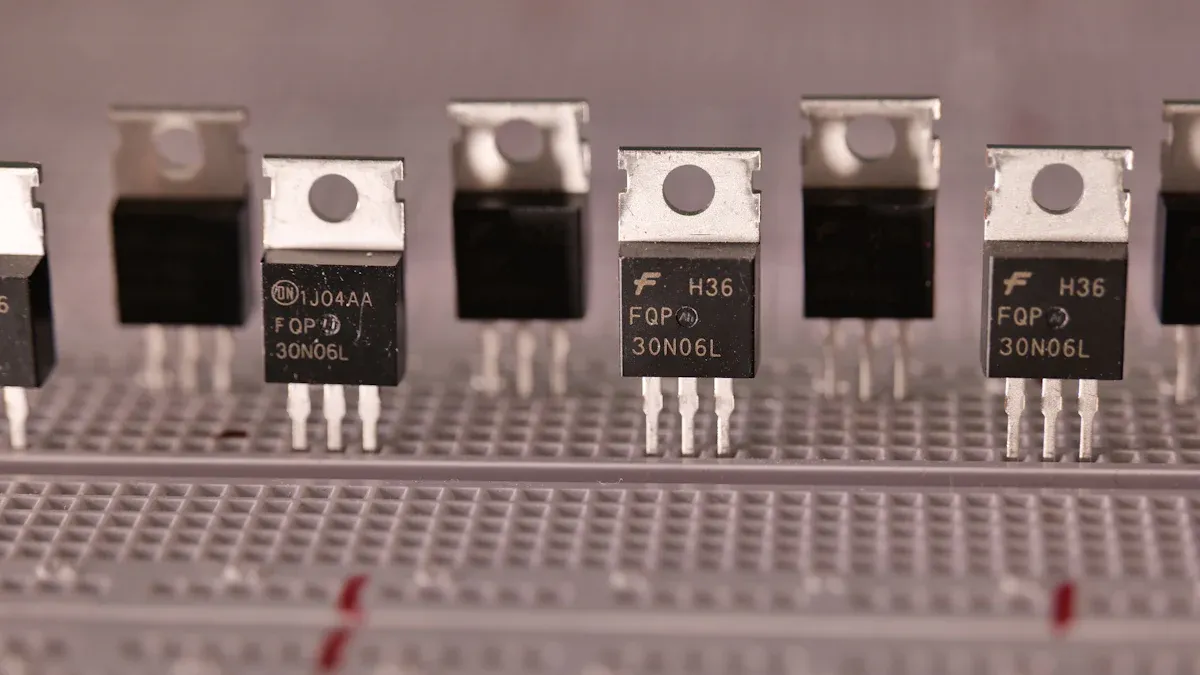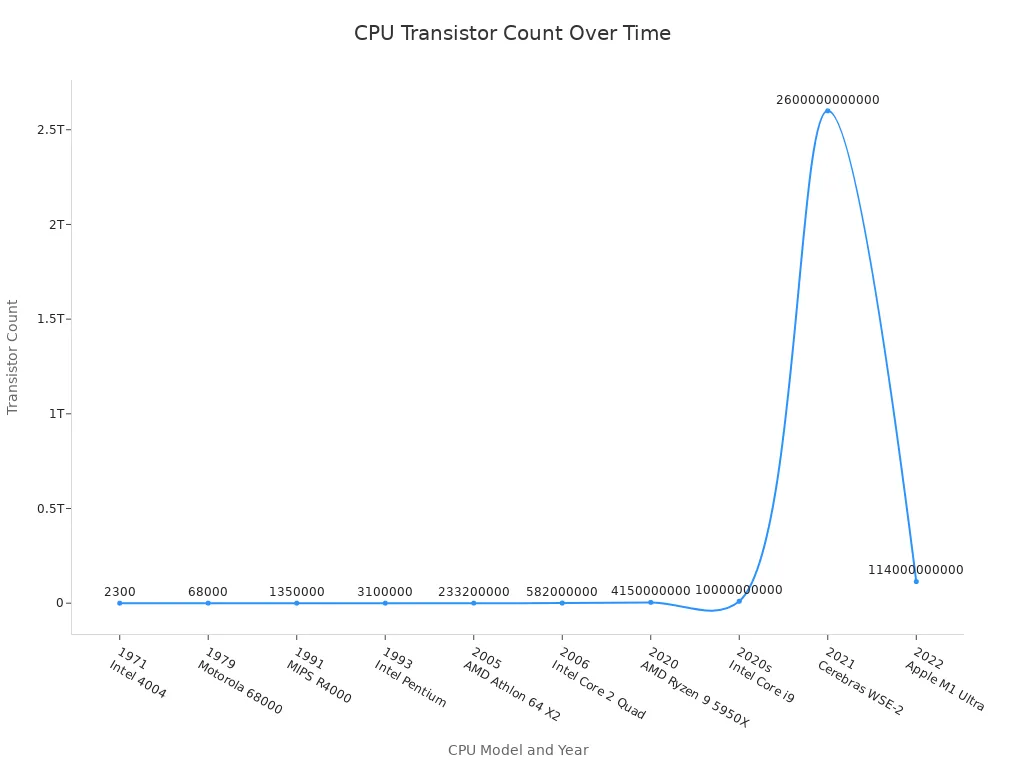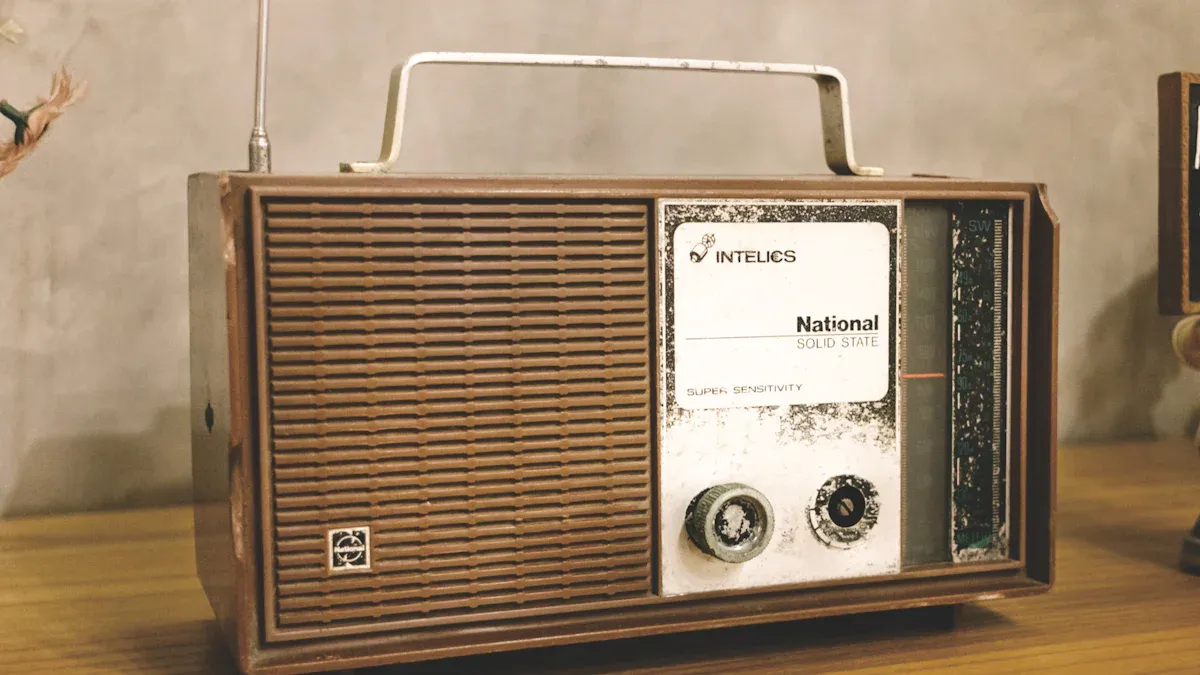What Is a Transistor in a Computer Chip and Why Does It Matter

A computer chip transistor is a tiny device made from silicon that acts like an electrical switch. You use it every time you turn on your phone or computer. This switch can turn electricity on or off, helping your computer process information and make decisions quickly. Billions of these transistors work together inside a chip, allowing your devices to run apps, play videos, and connect online.
Key Takeaways
A transistor is a tiny switch inside computer chips that controls the flow of electricity to process information as 1s and 0s.
Billions of transistors work together on a chip to make devices faster, more powerful, and energy-efficient.
Transistors act like light switches or water valves, turning electrical signals on and off very quickly to run apps and store data.
Over time, transistors have become much smaller, allowing more to fit on a chip and improving device performance and battery life.
Transistor technology drives advances in computers, smartphones, AI, and future innovations that will impact many areas of life.
What Is a Computer Chip Transistor

Basic Definition
A computer chip transistor is a tiny part made from special materials called semiconductors. You find these transistors inside every computer chip. They control the flow of electrical signals, acting as both switches and amplifiers. Most computer chip transistors use silicon because it is cheap, easy to find, and works well for electronics. Manufacturers shape silicon into thin wafers, then add tiny amounts of other elements like boron or phosphorus. This process, called doping, changes how the silicon conducts electricity. Metals such as copper or aluminum connect the transistors and help build the circuits inside the chip. You see millions or even billions of these transistors packed together in a single computer chip.
Note: Transistors come in different types, such as bipolar junction transistors (BJTs) and field-effect transistors (FETs). Each type has its own way of controlling current, but all serve the same basic purpose in a computer chip.
Switch and Amplifier Roles
You can think of a computer chip transistor as a tiny switch. When you send a small electrical signal to one part of the transistor, it lets a larger current flow through another part. If you remove the signal, the current stops. This on-and-off action is how your computer stores and processes information as 1s and 0s. The table below shows how a transistor acts as a switch:
Terminal/Condition | Description |
|---|---|
Base Voltage ≥ 0.7V | Small current flows into base, switch turns ON |
Resulting Action | Large current flows from collector to emitter (1) |
Base Voltage < 0.7V | No current flows into base, switch turns OFF |
Resulting Action | No current flows between collector and emitter (0) |
Besides switching, a computer chip transistor can also amplify signals. When you use it as an amplifier, a small input signal controls a much larger output signal. This is important for making weak signals strong enough to use in circuits. In digital circuits, transistors mostly act as switches, but in some parts of your device, they also boost signals so everything works smoothly.
A transistor can:
Amplify a weak signal to make it stronger.
Switch on and off very quickly, allowing your computer to process data fast.
Everyday Analogy
Imagine a computer chip transistor as a light switch in your room. When you flip the switch up, the light turns on. When you flip it down, the light turns off. The transistor does the same thing with electricity inside your computer chip. It turns the flow of electricity on or off, helping your device understand and process information.
You can also picture a transistor like a water valve. When you open the valve, water flows through the pipe. When you close it, the water stops. The transistor controls the flow of electricity in a similar way. This simple action, repeated billions of times, lets your computer chip do everything from running games to sending messages.
How Transistors Work
On and Off States
You can think of a computer chip transistor as a tiny gatekeeper for electricity. It has three parts: the base, the collector, and the emitter. When you send a small current to the base, the transistor lets a larger current flow from the collector to the emitter. If you remove the current from the base, the flow stops. This simple action creates two states:
On State (1): The transistor allows current to pass through, just like an open gate.
Off State (0): The transistor blocks the current, acting like a closed gate.
This switching between on and off lets your computer represent information as 1s and 0s, which is the language of digital devices. In a MOSFET, a type of computer chip transistor, the gate works like a capacitor. When you charge the gate, current flows; when you discharge it, the flow stops. This quick change between states is what makes computers so fast and reliable.
Tip: Imagine a faucet. When you turn the handle, water flows (on). When you close it, the water stops (off). A transistor does the same thing with electricity inside your computer.
Logic Gates
You use transistors to build logic gates, which are the basic tools for making decisions in a computer. Each logic gate takes one or more inputs and gives an output based on simple rules. For example, an AND gate only turns on if all its inputs are on. An OR gate turns on if at least one input is on. By connecting transistors in different ways, you create these gates.
Transistors work together in groups to form gates like NOT, AND, OR, NAND, NOR, and XOR. Each gate follows a truth table, which shows how the output depends on the inputs. Here is a simple example for an AND gate:
Input A | Input B | Output (A AND B) |
|---|---|---|
0 | 0 | 0 |
0 | 1 | 0 |
1 | 0 | 0 |
1 | 1 | 1 |
You find millions of these gates inside every processor. They let your computer add numbers, compare values, and make choices. Logic gates also help store information using special circuits called flip-flops and latches. These circuits remember data and help your device run programs and store files.
Billions in Action
Modern computer chips pack billions of transistors onto a single piece of silicon. Each computer chip transistor acts as a tiny switch, working with others to perform complex tasks. The more transistors you have, the more powerful and efficient your chip becomes. For example, the Apple M1 Ultra chip contains about 114 billion transistors, while older chips had only a few thousand.

As you add more transistors, you can:
Run more programs at once.
Store more data in memory.
Perform calculations faster.
Use less energy for each operation.
This huge number of transistors allows your phone, laptop, or gaming console to handle everything from streaming videos to running advanced games. The rapid switching of each computer chip transistor, turning on and off billions of times per second, is what gives modern devices their speed and power.
Evolution of Transistors

Early to Modern
You can see how much transistors have changed by looking at their earliest forms compared to what you find in today’s computer chips. The first transistors, invented in 1947, looked and worked very differently from the ones inside your phone or laptop now. Here’s a quick comparison:
Aspect | First Transistors (1947) | Modern Transistors (in computer chips) |
|---|---|---|
Base Material | Germanium | Silicon |
Contacts | Two gold foil contacts | Integrated nanoscale contacts within silicon-based ICs |
Physical Size | Relatively large, simple devices | Miniaturized to nanometer scale, extremely small |
Construction | Plastic triangle holding components together | Part of complex integrated circuits with billions of transistors |
Functionality | Electronic switches and amplifiers, replaced vacuum tubes | Highly efficient switches in complex microprocessor architectures |
Power Consumption | Less than vacuum tubes, higher than modern transistors | Extremely low power, high efficiency |
Material Stability | Germanium used due to silicon’s early instability | Silicon preferred for better thermal stability |
Electrical Properties | Less stable and predictable | More stable and predictable |
Manufacturing Impact | Pioneered transistor technology | Enabled massive integration and performance improvements |
You can trace the journey from the first point-contact transistor at Bell Labs in 1947 to the robust silicon transistors used today. Early devices used germanium, but engineers soon switched to silicon for better stability and performance. The invention of the planar process in 1959 made it possible to mass-produce reliable transistors, and the introduction of the MOSFET that same year set the stage for modern digital electronics.
Miniaturization
Transistors have shrunk dramatically over the decades. You would find the first transistors measured in millimeters, but now, modern transistors are only a few nanometers wide. Here’s how this miniaturization happened:
In 1947, transistors were about one centimeter wide, replacing bulky vacuum tubes.
The invention of the integrated circuit in 1958 allowed you to put multiple transistors on a single chip.
By the late 20th century, transistor sizes dropped to microns, and today, they measure just a few nanometers.
Technologies like FinFETs, 3D stacking, and extreme ultraviolet (EUV) lithography helped make this possible.
Now, you can fit billions of transistors on a chip the size of a fingernail.
Note: As transistors get smaller, you face new challenges like heat buildup and quantum effects. Scientists are exploring new materials and designs to keep making progress.
Moore’s Law
You might have heard of Moore’s Law. Gordon Moore, a co-founder of Intel, predicted in 1965 that the number of transistors on a chip would double about every two years. This idea guided the tech industry for decades. You saw computers get faster, smaller, and cheaper as a result. For many years, this prediction held true, with transistor counts doubling every 18 to 24 months.
Today, shrinking transistors further has become harder because you are working at the atomic level. Companies like TSMC still push the limits with advanced designs and new materials. While the pace of Moore’s Law has slowed, innovation continues. You benefit from faster and more powerful devices, thanks to the ongoing evolution of transistor technology.
Why Transistors Matter
Powering Technology
You rely on transistors every time you use a smartphone, laptop, or even a smart speaker. These tiny devices make your electronics powerful, fast, and energy-efficient. The miniaturization of transistors lets billions fit on a single chip, which means your devices can do more while staying small and light. Take a look at how transistors make this possible:
Feature | Explanation |
|---|---|
Miniaturization | Billions of transistors fit on a chip, making devices compact and powerful. |
Computational Power | More transistors mean faster multitasking and complex operations. |
Energy Efficiency | Modern transistors use less power, so your battery lasts longer and servers use less electricity. |
High-Speed Switching | Transistors switch on and off billions of times per second, enabling smooth performance. |
Reliability | No moving parts means your devices last longer and work more reliably. |
A computer chip transistor acts as the on/off switch for digital circuits. By combining millions of these switches, your devices can process information, run apps, and connect to the internet with ease.
Enabling Progress
Transistors have driven huge leaps in technology. As engineers pack more transistors onto chips, you see new features and smarter devices. Here are some ways this progress shows up in your life:
Powerful graphics cards (GPUs) handle advanced gaming and artificial intelligence.
Mobile processors, like Apple’s A13, use billions of transistors for fast, efficient performance.
Multi-core chips let you run several apps at once without slowing down.
System-on-chip designs combine many functions, making devices smaller and lighter.
Specialized chips for AI, IoT, and 5G make your devices smarter and more connected.
You benefit from faster computers, better battery life, and lower costs. The growth in transistor counts has also made artificial intelligence possible. Modern AI models need massive computing power, which comes from the billions of transistors in today’s chips. As a result, you see smarter assistants, better photo recognition, and even self-driving cars.
Future Impact
Transistor innovation will shape the future of technology and society. You can expect even more powerful computers, smarter robots, and breakthroughs in medicine and science. Engineers are exploring new materials and designs, such as 3D stacking and nano-scale switches, to keep improving performance and efficiency.
Future chips may use neuromorphic or quantum designs, opening new possibilities for artificial intelligence.
Transistor advances will help solve big challenges, like climate change, by making computing more energy-efficient.
Collaboration between scientists and engineers will drive the next wave of innovation.
You will see the impact of these changes in everything from healthcare to transportation. The computer chip transistor remains at the heart of this progress, powering the devices and ideas that shape your world.
Transistors power every modern electronic device you use, from computers to smartwatches. When you understand how transistors work, you see the huge leap from bulky vacuum tubes to today’s tiny, energy-saving chips. This progress made your devices faster, smaller, and smarter.
Ongoing research into new materials and designs keeps electronics moving forward, opening doors for future technology like AI and advanced healthcare.
Next time you use your favorite gadget, remember that transistors are the tiny heroes making it all possible.
FAQ
What is the main job of a transistor in a computer chip?
A transistor acts as a tiny switch. You use it to turn electrical signals on or off. This switching lets your computer process information as 1s and 0s.
How many transistors fit on a modern computer chip?
Modern chips can hold billions of transistors. For example, some smartphone chips have over 10 billion. More transistors mean faster and more powerful devices.
Why do smaller transistors matter?
Smaller transistors let you fit more on a chip. This boosts speed and saves energy. You get better performance and longer battery life in your devices.
Can transistors wear out or break?
Transistors last a long time because they have no moving parts. You might see problems only if a chip gets too hot or damaged. Most devices work for years without issues.
Tip: Keep your devices cool to help transistors last longer.
See Also
How Computer Chips Function And What They Are
An Overview Of Communication Chips And Their Operation
Understanding Current-Loop Transmitter Chips And Their Function
Exploring Applications Of Single Darlington Transistor IC Chips
